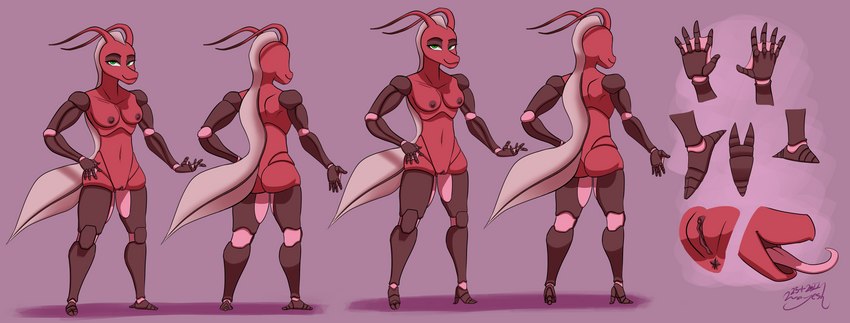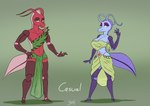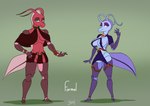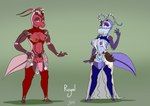
Description
Hydromel species ref
The Parasite World
A "degenerate universe": a comparatively tiny, partially formed, parasitic universe that is latched onto the Prime World (the universe as humans know it). This parasitic universe has few physical laws of its own and gets most of them from our universe.
The Parasite World occupies no physical space within the Prime World and can be accessed from anywhere by essentially falling into a lower energy state than what the Prime World's laws can support. Portals that produce this effect release energy when transporting objects/people from the Prime World to the Parasite World, but reversing the process requires significant energy input. This makes it very difficult to leave the Parasite World once you get there.
The vast majority of flora and fauna in the Parasite World are succubal or incubal; that is, they feed on sexual fluids and the potent magics they contain. Most beings that feed any other way are either Prime natives or descendants of Prime natives.
Sapients in the Parasite World tend to suffer from the “Vampire’s Dilemma”. They feed on sexual fluids, the magic within being far more energy efficient than standard foods that humans would eat. However, actually getting access to that food source is magnitudes less efficient than going out and hunting and killing an animal or grazing. Parasite sapients thus have great physical and magical abilities, but have to use nearly all of those abilities just to secure their next meal. This leaves little effort left to devote to things such as technological development, so succubus sapients are universally much more primitive than humans and advance far more slowly. In some cases, advancement has stalled entirely.
Hydromels
A species of bee-like sapients native to jungles in the Parasite World. Hydromels are succubi specialized in seducing and feeding on males of other species. As such, both of their sexes look, sound, and feel female by virtually any human measure. They are powerful swimmers and can hold their breath for extended periods of time, thanks to being descended from aquabees, an Order of various species of amphibious bee-like succubi.
Though hydromels primarily gain sustenance from semen, they can also drink (and in fact require) water as well, and are capable of eating ordinary food. Food cannot sustain them forever, but eating it does allow them to go longer between required feedings.
Hydromel Males
By human standards, hydromel males look and act like particularly tomboyish and/or butch females, but despite appearances they are in fact male. Being a species of succubi specialized in feeding on men, what looks like sexual organs are actually feeding apparatuses. The "vagina" on a male hydromel merely leads to the male's primary stomach, which processes any semen the male takes in. The males' actual reproductive organs are a set of internal testes in their lower abdomen area, which secrete jelly-like semen onto the lower abdomen and crotch area during sexual intercourse that interacts with receptors on the lower abdomen of a female. To a human, heterosexual hydromel intercourse resembles a furious lesbian makeout session or scissoring, depending on how the hydromels opt to accomplish it.
Hydromel males' breasts perform a completely different function compared to those of human females, despite their similar appearance. Rather than producing milk, hydromel males primarily produce honey. This honey is made from the excess nutrients resulting from digesting semen, and is extremely nutritious to most succubal species. This honey production is an anti-starvation measure, giving the species a semi-reliable way to store nutrients away for when sexual prey isn't available. To humans, the honey provides little long-term nutritional value but functions as a potent aphrodesiac and sexual stimulant, temporarily hijacking the human body's functions and forcing it to prioritize sexual output. This drastically increases human libido and semen output while lowering endurance and forcibly reducing refractory period. When used in reasonable doses and not overindulged, the results can be exhausting but are not harmful in the longterm for human prey.
(An aside: hydromel honey is also a useful magical focus and medium. Hardly the most powerful around and one they can't always use due to it also being a food stockpile, but it is useful in a pinch.)
To facilitate hunting, male hydromels can also release a substance that acts as an aphrodesiac and mild hallucinogen. the pollen-like substance is released from their skin, especially the membrane of their tadpole-like tail and fin. The substance is described as smelling like a "sweet, honeyed alcohol" and was an inspiration for the species' name. The pollen has an effect on the body similar to that of hydromel honey, though to a lesser degree. Historically, Hydromels were known to seed lure traps using this pollen. Laying out food and water for prey that is seeded with the pollen. The prey's body can thus spend hours "marinating" in preparation for feeding, while the food and water prevents the prey's increased appetite and thirst from overstressing their body. The hallucinogenic effects also reduce the prey's ability to fight back when the hydromels come by to collect them.
Relative to humans, hydromel males are on average noticeably shorter, though this is believed to be caused by relative differences in nutrition and healthcare. Especially healthy hydromel males have been known to grow much taller than the human average. The chitin on their limbs makes them tougher than humans by most measures, and they have greater strength relative to humans as well. However, their endurance is significantly weaker. They fare poorly in protracted engagements and rely on their natural abilities to prevent a "fair" fight.




There are no comments.
Login to respond »